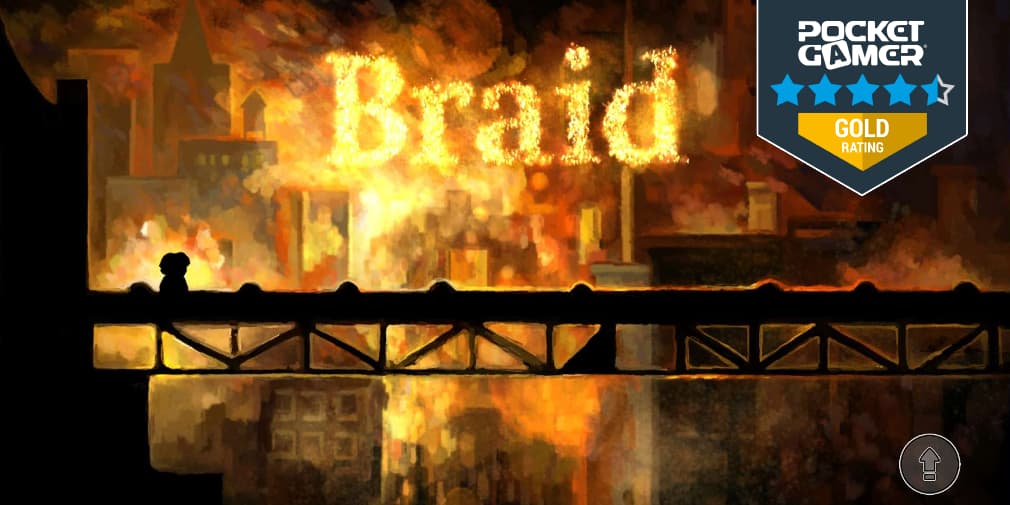
- A puzzle game about jumping and controlling time
- Beautiful and dreamlike artwork
- A mercurial narrative left to you to interpret through gameplay
Many of us still don’t understand exactly how time works, but that won’t stop us from turning it into a narrative device of chronological superpower. When devs first realized that time could be manipulated in so many ways, it became a rockstar in gameplay with one of the lead performers being Jonathan Blow.
This creator famously crafted Braid over several years using his resources and working with artist David Hellman. It exploded in popularity as a creative 2D puzzle platformer with a non-linear narrative that helped strengthen the argument for video games as an art form. Now over 16 years later, it arrives through Netflix as Braid Anniversary Edition.
What is Braid?
To this day, many are debating over the true meaning behind Braid’s story. It starts seemingly straightforward but becomes more complex through new details and gameplay. It all begins with a young well-dressed man named Tim arriving in an area of interconnected worlds. Various texts establish that Tim once had a loving and affectionate relationship with an unnamed princess. At some point during their time together, the two had a falling out and Time lost touch with her. Aiming to make things right and hopefully recover what he once had, Tim sets out on a journey to rescue the princess from an unidentified monster. Since Tim gains various powers over time, it’s time that he uses them.
Weaving the Braid

Time manipulation mechanics hit the mainstream in the mid-to-late 2000s and Braid was in the right position to make the most of them. Time may be a complex concept but there are many aspects of it that we can interpret quite easily. This is what Braid does as it leads you into each of its worlds. The opening level of each world lets you see just what kind of time mechanics are in play and takes time to ease in environmental elements that may or may not be affected by them. Tim never loses the power to rewind seemingly limitless time so you always have a pretty strong “Undo” button if things get too out of shape.
The whole challenge is based on puzzles with each world revolving around a particular mechanic. It’s presented as a sort of “learn as you go” experience where you won’t have all the information you need unless you explore the level. This feeds into Tim’s trademark rewinding mechanic which will reveal new information when used and is a whole other kind of backtracking. The more you play, the more you see how all of the pieces of the puzzle come together which is quite literally reflected in the fact that you’re collecting pieces of a puzzle to complete a portrait that reveals more of the story.
Also, as it once was and so it returns, the visual art style is beautiful. The whole appearance has the feel and look of living paint which is most present in Tim and the environment. The overall softness and blur throughout the game give the idea that you’re playing through a dream or perhaps Tim’s fantasies of being a hero. It makes you question what is real and if what you’re doing will truly fix things.
A Tangled Braid

As an anniversary addition, we can expect a nice coat of polish on the visuals and maybe some tightening of the controls. However, there is one big issue that has remained with the game since its first appearance: The unfixable key. There are moments when you’ll be given a key that isn’t affected by time powers and can be used to unlock a door. If you use it on the wrong door, the key breaks and can’t be fixed so you need to reset the whole world. Here’s a free tip: The right door is never the one that seems “easiest” to reach.
Then there’s the translation of the game’s mechanics to touchscreen controls. All things considered, Braid is a rather simple game in terms of gameplay. The problem is that the associated touchscreen controls are far too precise to be used in a game where hectic moments are commonplace. You can press the jump button, but if you’re not pressing it dead center, Tim won’t budge. Holding the rewind button to speed things up or down can also cause you to move the buttons to another point of the screen until you forget where they started. Practice pressing the same part of the screen over and over again until you’re certain that you can be consistent.
Braid the Timeline

Braid Anniversary Edition is a modern update of the 2D puzzle-platforming and time-manipulation adventure. All the beauty, mystery, creativity, and challenge of the game are still there to make you think and wonder. An old issue with fickle keys returns and the touchscreen can be a bit picky about finger placement, but these can be conquered with enough time. And that’s what Braid is: About time.